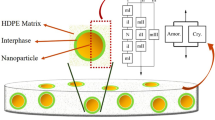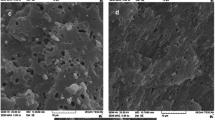Abstract
The physical/mechanical characteristics of the polymer/particle interphase region have been always considered to be dependent on the surface chemical structure of the nanoparticles and their interactions with the polymer chains. In addition, it is repeatedly reported that the interphase-related parameters (e. g., thickness, tensile modulus and strength, yield strength, thermal conductivity) can be considered constant under any process conditions. Accordingly, in this study, a comprehensive investigation was performed to define the effects of nanoparticles content, aggregation/agglomeration factor and type of the exerted driving force on the characteristics of the polymer/particle interphase region. To this end, different experimental/analytical approaches were adapted by which it was possible to precisely characterize the internal structure of PS/silica and PMMA/silica nanocomposite samples based on their thermal and mechanical properties. The mechanical characteristics were evaluated using a developed form of Zare’s model and in the case of thermal characteristics, two new analytical models were proposed based on equivalent box model (EBM). According to the results, it was revealed that the increment of the nanoparticle content increased the thermal conductivity of the interphase while decreased its thickness and yield strength. Moreover, it was found that the aggregation/agglomeration of nanoparticles had negative effects on the interphase thermal properties which were negligible at low contents.
Graphic abstract






Similar content being viewed by others
References
Pesetskii SS, Bogdanovich SP (2013) Polymer composites and nanocomposites. In: Wang QJ, Chung Y-W (eds) Encyclopedia of tribology. Springer, Boston. https://doi.org/10.1007/978-0-387-92897-5_823
Masoud EM, Liu L, Peng B (2020) Synthesis, characterization, and applications of polymer nanocomposites. J Nanomater 2020:5439136. https://doi.org/10.1155/2020/5439136
Inamuddin M, Thomas S, Kumar Mishra R, Asiri AM (2019) Sustainable polymer composites and nanocomposites. Springer International Publishing, Switzerland
Paublo DJ (2012) Tribology of nanocomposites. Springer-Verlag, Heidelberg
Power AJ, Remediakis IN, Harmandaris V (2021) Interface and interphase in polymer nanocomposites with bare and core-shell gold nanoparticles. Polymers (Basel) 13:541
Hodgkinson JM (2012) Testing the strength and stiffness of polymer matrix composites. In: Robinson P, Greenhalgh E, Pinho S (eds) Failure mechanisms in polymer matrix composites. Woodhead Publishing, Cambridge. https://doi.org/10.1533/9780857095329.1.129
Sharifzadeh E (2019) Modeling of the mechanical properties of blend based polymer nanocomposites considering the effects of Janus nanoparticles on polymer/polymer interface. Chinese J Polym Sci 37:164–177. https://doi.org/10.1007/s10118-019-2178-3
Sharifzadeh E, Ghasemi I, Karrabi M, Azizi H (2014) A new approach in modeling of mechanical properties of nanocomposites: effect of interface region and random orientation. Iran Polym J 23:835–845. https://doi.org/10.1007/s13726-014-0276-1
Sharifzadeh E, Ghasemi I, Qarebagh AN (2015) Modeling of blend-based polymer nanocomposites using a knotted approximation of Young’s modulus. Iran Polym J 24:1039–1047. https://doi.org/10.1007/s13726-015-0391-7
Sharifzadeh E (2019) Modeling of the tensile strength of immiscible binary polymer blends considering the effects of polymer/polymer interface and morphological variation. Chinese J Polym Sci 37:1176–1182. https://doi.org/10.1007/s10118-019-2274-4
Zhai S, Zhang P, Xian Y, Zeng J, Shi B (2018) Effective thermal conductivity of polymer composites: theoretical models and simulation models. Int J Heat Mass Transfer 117:358–374. https://doi.org/10.1016/j.ijheatmasstransfer.2017.09.067
Netravali AN, Mittal KL (2016) Interface/Interphase in polymer nanocomposites. Wiley, Massachusetts
Jesson DA, Watts JF (2012) The interface and interphase in polymer matrix composites: effect on mechanical properties and methods for identification. Polym Rev 52:321–354. https://doi.org/10.1080/15583724.2012.710288
Ji XL, Jing JK, Jiang W, Jiang BZ (2002) Tensile modulus of polymer nanocomposites. Polym Eng Sci 42:983–993. https://doi.org/10.1002/pen.11007
Sharifzadeh E, Amiri Y (2021) The effects of morphological variation and polymer/polymer interface on the tensile modulus of binary polymer blends: a modeling approach. J Polym Eng 41:109–118. https://doi.org/10.1515/polyeng-2020-0013
Buryan OK, Novikov VU (2002) Modeling of the interphase of polymer-matrix composites: determination of its structure and mechanical properties. Mech Compos Mater 38:187–190. https://doi.org/10.1023/A:1016008432083
Maghami S, Shahrooz M, Mehrabani-Zeinabad A, Zornoza B, Sadeghi M (2020) Characterization of the polymer/particle interphase in composite materials by molecular probing. Polymer 205:122792. https://doi.org/10.1016/j.polymer.2020.122792
Jain S, Goossens JGP, Peters GWM, van Duin M, Lemstra PJ (2008) Strong decrease in viscosity of nanoparticle-filled polymer melts through selective adsorption. Soft Matter 4:1848–1854. https://doi.org/10.1039/B802905A
Zamanian M, Ashenai Ghasemi F, Mortezaei M (2021) Interphase characterization and modeling of tensile modulus in epoxy/silica nanocomposites. J Appl Polym Sci 138:49755. https://doi.org/10.1002/app.49755
De Gennes P-G (1976) Scaling theory of polymer adsorption. J Phys 37:1445–1452. https://doi.org/10.1051/jphys:0197600370120144500
Zare Y, Rhee KY (2020) Study on the effects of the interphase region on the network properties in polymer carbon nanotube nanocomposites. Polymers 12:182
Boyard N (2016) Heat transfer in polymer composite materials: forming processes. Wiley, New Jersey
Thomas S, Joseph K, Malhotra SK, Goda K, Sreekala MS (2013) Polymer composites nanocomposites. Wiley, New Jersey
Ashraf MA, Peng W, Zare Y, Rhee KY (2018) Effects of size and aggregation/agglomeration of nanoparticles on the interfacial/interphase properties and tensile strength of polymer nanocomposites. Nanoscale Res Lett 13:214. https://doi.org/10.1186/s11671-018-2624-0
Zare Y (2016) Study of nanoparticles aggregation/agglomeration in polymer particulate nanocomposites by mechanical properties. Compos Part A Appl Sci Manuf 84:158–164. https://doi.org/10.1016/j.compositesa.2016.01.020
Sharifzadeh E, Tohfegar E, Safajou Jahankhanemlou M (2020) The influences of the nanoparticles related parameters on the tensile strength of polymer nanocomposites. Iran J Chem Eng (IJChE) 17:65–78. https://doi.org/10.22034/ijche.2020.234505.1337
Gao S-L, Mäder E (2002) Characterisation of interphase nanoscale property variations in glass fibre reinforced polypropylene and epoxy resin composites. Compos Part A Appl Sci Manuf 33:559–576. https://doi.org/10.1016/S1359-835X(01)00134-8
Ding Y, Tran KN, Gear JA, Mainwaring D, Murugaraj P (2008) The influence of interphase between nanoparticles and matrix on Young’s Modulus of nanocomposites. Procc Int Conf NanoSci NanoTechnol. https://doi.org/10.1109/ICONN.2008.4639237
Sharifzadeh E, Parsnasab M (2021) Direct and reverse desymmetrization process in O/W Pickering emulsions to produce hollow graphene oxide Janus micro/nano-particles. Colloids Surf A Physicochem Eng Asp 619:126522. https://doi.org/10.1016/j.colsurfa.2021.126522
Sharifzadeh E, Amiri Y (2020) The effects of the arrangement of Janus nanoparticles on the tensile strength of blend-based polymer nanocomposites. Polym Compos 41:3585–3593. https://doi.org/10.1002/pc.25645
Ciprari D, Jacob K, Tannenbaum R (2006) Characterization of polymer nanocomposite interphase and its impact on mechanical properties. Macromolecules 39:6565–6573. https://doi.org/10.1021/ma0602270
Boutaleb S, Zaïri F, Mesbah A, Naït-Abdelaziz M, Gloaguen JM, Boukharouba T, Lefebvre JM (2009) Micromechanics-based modelling of stiffness and yield stress for silica/polymer nanocomposites. Int J Solids Struct 46:1716–1726. https://doi.org/10.1016/j.ijsolstr.2008.12.011
Mittal V (2013) Modeling and prediction of polymer nanocomposite properties. Wiley, Weinheim
Bergman TL, Lavine AS, Incropera FP, DeWitt DP (2011) Fundamentals of heat and mass transfer. Wiley, Jefferson
Griskey RG (1995) Heat transfer in polymer systems. Polymer process engineering. Springer, Dordrecht
Zare Y (2016) Modeling the yield strength of polymer nanocomposites based upon nanoparticle agglomeration and polymer–filler interphase. J Colloid Interface Sci 467:165–169. https://doi.org/10.1016/j.jcis.2016.01.022
Author information
Authors and Affiliations
Corresponding author
Ethics declarations
Conflict of interest
The authors declare that they have no conflicts of interest.
Rights and permissions
About this article
Cite this article
Sharifzadeh, E. Evaluating the dependency of polymer/particle interphase thickness to the nanoparticles content, aggregation/agglomeration factor and type of the exerted driving force. Iran Polym J 30, 1063–1072 (2021). https://doi.org/10.1007/s13726-021-00956-3
Received:
Accepted:
Published:
Issue Date:
DOI: https://doi.org/10.1007/s13726-021-00956-3




